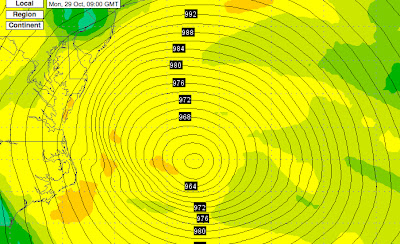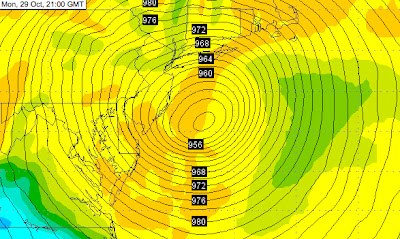But what has not been discussed in depth is the extraordinary transformation that will occur as Sandy makes landfall and moves inland....from a tropical to an extratropical storm, the first with a warm core and the latter with a cold core. I will talk about that here.
Right now Hurricane Sandy is almost exactly one day from landfall on New Jersey. It possesses sustained winds of 75 mph and a central pressure of 950 hPa, and is very large storm and will expand even more. Here is a recent infrared image, showing the band of moisture feeding into the center of the storm.

As I have mentioned before, hurricanes and tropical storms derive their energy from the warmth and moisture of warm oceans, and Sandy is no exception. Such tropical storms are warm-core systems, with the warmest air in their centers. In general, tropical storms are not found in regions with large horizontal changes in temperature.
Recently, there has been a substantial warm anomaly of the sea surface temperature (SST) of the western Atlantic (SST much warmer than normal), which helps tropical systems like Sandy move northward and stay strong longer than normal. Here is a recent map showing the SST anomaly: much warmer than normal along the path of Sandy, by over 1.5C! So a very attractive welcome mat had been laid for tropical storms over the western Atlantic.

Now midlatitude or extratropical storms get their energy not from warm oceans, but rather horizontal temperature changes---generally warmer to the south, cooler to the north. It turns out that the temperature changes on our planet are concentrated in the midlatitudes...and this temperature gradient fuels nearly all of the storms we experience in the winter. Midlatitude storms tend to be cold-core, with the coolest temperatures in their center.
Sometimes a tropical storm moves northward and undergoes an amazing transformation, from a warm core tropical system to a cold-core extratropical system, and switches its energy supply from the warmth and moisture of a tropical ocean to the temperature gradients of the midlatitudes. This is called Extratropical Transition (ET) in the business.
Sandy is about to go through the transformation.
Let me show you. The figures below show you the temperatures and pressure pattern (actually heights of the 850 hPa pressure surface) at around 5000 ft above sea level for three times (Monday morning, Monday evening, and Tuesday morning--Seattle Time). At the initial time there is warm air at the center of the storm (the dark orange color). Fairly symmetric structure (which is typical of tropical systems).

By tomorrow evening, just as the storm is making landfall, the warm core is fading, and temperature structure is becoming much more asymmetric.
 By Tuesday morning, the transformation is complete....cold air has reached the center of the storm and the warmest air is found far to the east of the center
By Tuesday morning, the transformation is complete....cold air has reached the center of the storm and the warmest air is found far to the east of the center
Many tropical storms weaken when they go through this transition, but for a small subset the opposite occurs. The two energy sources work synergistically for a while, resulting in an strengthening and expanding system....such is the forecast fate of Sandy.
In fact, during this transition stage, Sandy will continue to intensity until it makes landfall. Here is the latest forecast from the NWS NAM model:
956 hPa low center at 2 AM Monday morning (PDT)

12 hours later 948 hPa pressure (2 PM Seattle Time).

My next blog will take a look at the scorecard for this storm....and return to talking about Northwest weather. And there is a lot to talk about, including an atmospheric river situation setting up and 5-10 inches forecast over the next 72 hr over NW mountains.

 With a large low center center over the NE Pacific and persistent strong flow pushing eastward to our south, northern CA is going to get hammered during the next several days.
With a large low center center over the NE Pacific and persistent strong flow pushing eastward to our south, northern CA is going to get hammered during the next several days. Tonight I will premiere a new figure created by UW WRF modeler Dave Ovens: 72hr snowfall! Lots (feet) of snow over the mountains of BC, and the higher elevations in the Cascades do very well indeed (foot or more). Most of the accumulation at pass and ski area elevation will occur later in the weekend as the freezing level drops and the wind direction becomes more westerly. The Sierra Nevada range goes to white (literally)--more than 45 inches of snow at higher elevations! The folks at Tahoe must be salivating.
Tonight I will premiere a new figure created by UW WRF modeler Dave Ovens: 72hr snowfall! Lots (feet) of snow over the mountains of BC, and the higher elevations in the Cascades do very well indeed (foot or more). Most of the accumulation at pass and ski area elevation will occur later in the weekend as the freezing level drops and the wind direction becomes more westerly. The Sierra Nevada range goes to white (literally)--more than 45 inches of snow at higher elevations! The folks at Tahoe must be salivating.  Here is a close up of the 72h snowfall ending on Monday at 4PM for Washington. Baker and Rainier will be buried. Stevens, at least a foot. Snoqualmie will pick up a half-foot or so. Not sure whether it will be enough to allow them to open.
Here is a close up of the 72h snowfall ending on Monday at 4PM for Washington. Baker and Rainier will be buried. Stevens, at least a foot. Snoqualmie will pick up a half-foot or so. Not sure whether it will be enough to allow them to open.
 This offshore pressure gradient will get an added boast as a weak low pressure disturbance, embedded in this giant low rotates around near us. There are several places that will get a good blow from this: offshore over the eastern Pacific, along the western WA foothills (hello Enumclaw, Black Diamond, and North Bend), and along the western portions of the Strait of Juan de Fuca. And later in the event NW Washington get strong winds. Lets look at the last WRF surface sustained (not gust) winds for the next day. First, 4 AM tomorrow (Wed). 20 kt sustained in the foothills (some folks will get gust to 40), and accelerating winds in the Strait, with sustained 25+ kt near Tatoosh Island.
This offshore pressure gradient will get an added boast as a weak low pressure disturbance, embedded in this giant low rotates around near us. There are several places that will get a good blow from this: offshore over the eastern Pacific, along the western WA foothills (hello Enumclaw, Black Diamond, and North Bend), and along the western portions of the Strait of Juan de Fuca. And later in the event NW Washington get strong winds. Lets look at the last WRF surface sustained (not gust) winds for the next day. First, 4 AM tomorrow (Wed). 20 kt sustained in the foothills (some folks will get gust to 40), and accelerating winds in the Strait, with sustained 25+ kt near Tatoosh Island. By 4 PM tomorrow, 30+ kt over the western Strait and similar winds northeast of the Olympics. Those poor, sunburned folks in Sequim will get now be getting some wind burns as well. Too windy for golf.
By 4 PM tomorrow, 30+ kt over the western Strait and similar winds northeast of the Olympics. Those poor, sunburned folks in Sequim will get now be getting some wind burns as well. Too windy for golf. The western Strait can be very windy during such offshore flow, with air accelerating towards the west. Strong winds, lots of rocks, and often clouds/fog make this region very dangerous for marine traffic, and, in fact, there have been numerous shipwrecks there, giving it the appellation of "Graveyard of the Pacific." During the days of sail (1830-1925) there were 137 major shipwrecks in the immediate vicinity of the entrance to the Strait. A major and tragic example is the 1906 shipwreck of the Valencia, with the loss of nearly 150 lives (see graphic).
The western Strait can be very windy during such offshore flow, with air accelerating towards the west. Strong winds, lots of rocks, and often clouds/fog make this region very dangerous for marine traffic, and, in fact, there have been numerous shipwrecks there, giving it the appellation of "Graveyard of the Pacific." During the days of sail (1830-1925) there were 137 major shipwrecks in the immediate vicinity of the entrance to the Strait. A major and tragic example is the 1906 shipwreck of the Valencia, with the loss of nearly 150 lives (see graphic).

 Snow? We will have relatively warm, southwesterly flow so Snoqualmie is out of luck. Very marginal for Stevens. Want snow? You will have to go high...Baker, Crystal, and Whistler.
Snow? We will have relatively warm, southwesterly flow so Snoqualmie is out of luck. Very marginal for Stevens. Want snow? You will have to go high...Baker, Crystal, and Whistler.

 Photo below this is a road walk
Photo below this is a road walk Photo below- not much snow at 4000 feet. No snowshoes needed now
Photo below- not much snow at 4000 feet. No snowshoes needed now
 Driving Directions: From Enumclaw drive on State Highway 410 east and just before you get to the small town of Greenwater turn left on logging road FS 7125. This is just past MP 42. If you reach the town you have gone too far. Follow logging road FS 7125 then bear left which go about 1.5 miles and park at gate.Trail Directions: Follow road to point at about 3900 feet which is 1800 foot gain and 4 miles one way. See our track below.Always bring map-compass-GPS as these directions are the best estimates.
Driving Directions: From Enumclaw drive on State Highway 410 east and just before you get to the small town of Greenwater turn left on logging road FS 7125. This is just past MP 42. If you reach the town you have gone too far. Follow logging road FS 7125 then bear left which go about 1.5 miles and park at gate.Trail Directions: Follow road to point at about 3900 feet which is 1800 foot gain and 4 miles one way. See our track below.Always bring map-compass-GPS as these directions are the best estimates.